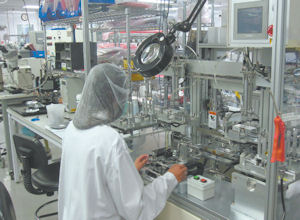Quallion LLC, the largest battery cell manufacturer in the U.S., soon will open a new 20,000-square-foot plant in Santa Clarita, a move that enables the company to produce batteries for satellites. The new plant will feed components for final assembly at the company’s main production hub in Sylmar, said Quallion President Paul Beach. “As we build more and create more jobs in Santa Clarita, we are creating more jobs down in Sylmar,” he said. Quallion employs nearly 200 workers at its Sylmar headquarters. It’s premature to project how many jobs will be created in the future, Beach said. The company was founded by Alfred Mann and Hisashi Tsukamoto in 1998, and has positioned itself as an industry leader in developing batteries for use in complicated environments. It currently makes power supplies for medical devices used in the human body, as well as batteries for transportation and military uses. Battery cells for satellites represent a growth area for the company, which in 2006 received a multi-million dollar, multi-year contract from the U.S. Department of Defense to produce materials used in large satellite battery cells. In September 2011, it launched the Tactical Microsatellite, powered by a Quallion battery cell. The satellite assists soldiers to use a handheld radio for communication on the move without having to set up antennae in the field for data transmission. Now, with the first launch a success, the company is preparing for increased production of the batteries, as well as conducting additional research and development efforts, Beach said. He anticipates the production line to operate in Santa Clarita within the first quarter of the year. Employees will split their time between that location and the Sylmar plant. Additional hires will follow demand, Beach said. Quallion is one of a few U.S. companies to make lithium ion batteries, as much of that manufacturing is done in China, Taiwan and Japan, said Martin Reynolds, an analyst with Gartner Inc., an information technology research and advisory company. U.S. battery manufacturers tend to be in the high-end, lower-volume markets, Reynolds said. Examples include A123 Systems in Michigan and Valence in Texas, both of which supply the auto industry. “If there is an unusual power requirement you will find a U.S. company doing it,” he said. Quallion has been growing its business and operations the past three years. It expanded the Sylmar headquarters since 2008 by adding 50,000-square feet of production capacity and has hired more than 100 new employees during the period. The company has received industry recognition for its batteries including a supplier performance excellence award from Boeing Corp. and inclusion on the Clean Tech 50 list from IEEE Spectrum magazine. In 2010, Quallion received a $6.8 million grant from the California Energy Commission to develop an automated manufacturing line for components used in batteries for electric vehicles. The production line can also be used for the satellite batteries. “They are synergistic programs,” Beach said. Beach would not disclose the company’s investment in equipment and interior upgrades at the Santa Clarita facility, which it will lease in the Mann Biomedical Park, a 167-acre complex named for Quallion’s co-founder. Medical device makers Bioness Inc. and Boston Scientific are among the tenants located there. Jonas Peterson, president and CEO of the Santa Clarita Valley Economic Development Corp., said Quallion will fit in well with the growing biomed and aerospace clusters in the area. “They are exactly the type of company we would like to see more of here,” Peterson said, noting that Mann Park is attractive to companies like Quallion because of the privacy it affords and the proximity of like-minded firms. It wasn’t by design that Quallion took space at the park named for Mann. The company had been working with the Los Angeles Department of Water and Power about moving into unused space owned by the department, Beach said. After a lengthy process of looking all over the Los Angeles basin, the Santa Clarita site was deemed the best. Among the benefits was a location in a non-residential area conducive for the wet chemistry activity being done there, Beach said. “It was perfect for what we are doing and what we needed to get the project up and running,” Beach said.
